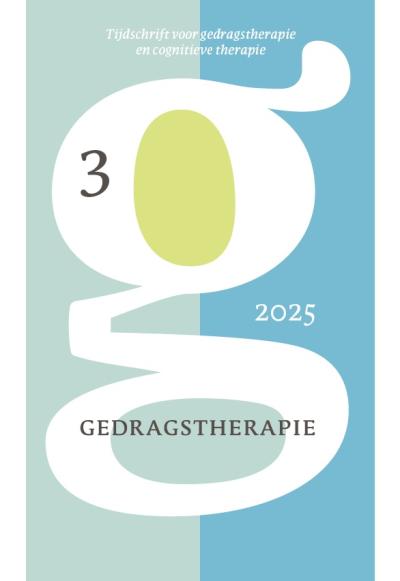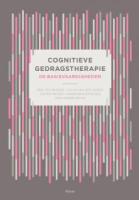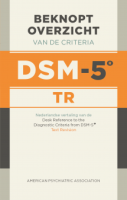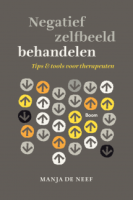Inhoud
Temperament, hechting en persoonlijkheidsproblematiek bij jongvolwassenen in de ambulant ggz
Samenvatting
In deze studie is de relatie onderzocht tussen temperamentskenmerken, hechtingsstijlen en persoonlijkheidsproblematiek bij 17 tot en met 23- jarige jongvolwassenen (N = 102), die in behandeling waren bij een ambulante geestelijke gezondheidszorg instelling. Meer specifiek is de samenhang van negatieve affectiviteit/neuroticisme en doelgerichte controle met cluster C persoonlijkheidsproblematiek nagegaan. Negatieve affectiviteit wordt gezien als een reactieve temperamentfactor en doelgerichte controle als een regulatieve temperamentfactor. Verder is ook de samenhang van hechtingsstijl met persoonlijkheidsproblematiek en negatieve affectiviteit onderzocht. De jongvolwassenen beoordeelden zichzelf op de Adult Temperament Questionnaire (Rothbart, 2000), de Relationship Questionnaire (Bartholomew & Horowitz, 1991) en de Personality Diagnostic Questionnaire Revised (Hyler & Rieder, 1982). De onderzoeksresultaten gaven aan dat negatieve affectiviteit positief en doelgerichte controle negatief geassocieerd bleken met de ernst van persoonlijkheidsproblematiek. Zowel negatieve affectiviteit als doelgerichte controle verklaarden een unieke en significante proportie van de variantie in cluster B en in de ernst van persoonlijkheidsproblematiek. De interactie tussen negatieve affectiviteit en doelbewuste controle leverde geen significante bijdrage aan de verklaarde variantie in persoonlijkheidsproblematiek. Variantie in Cluster C problematiek werd alleen significant voorspeld door negatieve affectiviteit. Hechtingsstijl verschafte geen significante unieke bijdrage aan de proportie verklaarde variantie in persoonlijkheidsproblematiek. De interactie tussen negatieve affectiviteit en hechtingsstijl leverde een significante bijdrage aan de ernst van persoonlijkheidsproblematiek en op clusterniveau voor het A en B cluster, maar niet voor cluster C.
Literatuur
- Ainsworth, M. D., Blehar, M., Waters, E., & Wall, S. (1978). Patterns of Attachment: A Psychological Study of the Strange Situation. New Jersey: Lawrence Erlbaum Associates.
- Akkerhuis, G.W., Kupka, R.W., Groenestijn, M.A.C. van, et al. (1996). PDQ-4+: vragenlijst voor persoonlijkheidskenmerken. Lisse: Swets & Zeilinger.
- Andrea, H., & Verheul, R. (2007). Categoriale classificatie, epidemiologie en comorbiditeit. In Eurlings-Bontekoe, E.H.M., Verheul, R., Snellen, W.M. (Eds), : Handboek persoonlijkheidsproblematiek (pp. 75-101). Houten: Bohn Stafleu van Loghum.
- APA (American Psychiatric Association) (1980). Diagnostic and statistical manual of mental disorders (3th ed.). Washington DC.
- APA (American Psychiatric Association) (1986). Diagnostic and statistical manual of mental disorders (3th ed. Revised). Washington DC.
- APA (American Psychiatric Association) (1994). Diagnostic and statistical manual of mental disorders (4th ed.). Washington DC: American Psychiatric Press.
- Arntz, A. (1997). Cognitieve theorieën. In H. van der Molen, S. Perreijn, & M. van den Houst (Eds.), Klinische psychologie. Theorieën en psychopathologie. (pp.175-215). Groningen: Wolters-Noordhoff.
- Asendorpf, J.B., & Van Aken, M.A.G. (2003). Validity of Big Five Personality Judgments in Childhood: A 9 Year Longtidinal Study. European Journal of Personality, 17, 1-17.
- Bartholomew, K., & Horowitz, L. M. (1991). Attachment styles among young adults; A test of a four-category model. Journal of Personality and Social Psychology, 61, 226-244.
- Beck, A.T. (1964). Thinking and Depression. Archives of General Psychiatry, 10, 561-571. Bowlby, J. [1969] (1999). Attachment. Attachment and Loss (vol. 1) (2nd ed.). New York: Basic Books.
- Bretherton, I. (1990). Communication patterns, internal working models and the Inter generational transmission of attachment relationships. Infant Mental Health Journal, 11, 237-251.
- Bronfenbrenner,U. (1986). Recent advances in the ecology of human development. In: R.K. Silbereisen, K. Eyferth, G. Rudinger (Eds.) Development as Action in Context: Problem Behavior and Normal Youth Development. Springer-Verlag, Berlin.
- Caspi, A., Roberts, B.W., & Shiner, R.L. (2005). Personality Development: Stability and Change. Annual Review of Psychology, 56, 453-484.
- Cohen, P., Crawford, T.N., Johnson, J.G., & Kasen, S. (2005). The children in de Community Study of Developmental Course of Pediatric Disorder, 19, 466-486.
- Derryberry, D., & Reed, M.A. (2002). Anxiety-relates attentional biases and their regulation by attentional control. Journal of Personality and Social Psychology, 111, 115-236.
- Derryberry, D. & Rothbart, M.K. (1988). Arousal, affect, and attention as components of temperament. Journal of Personality and Social Psychology, 55, 958-966.
- Dingemans, P.M.A.J., & Sno, H.N. (2004). Meetinstrumenten bij persoonlijkheidsstoornissen. Tijdschrift voor Psychiatrie. 46. 705-708.
- Eisenberg, N., Cumberland, A., Spinrad, T.L., Fabes, R.A., Shepard, S., Reiser, M., et al. (2001). The relations of regulation and emotionality to children's externalizing and internalizing behaviour problems. Child Development, 72, 1112-1134.
- Evans, D.E., & Rothbart, M.K. (2007). Developing a model for adult temperament. Journal of Research in Personality, 41, 868–888.
- Eysenck, H.J. (1999). Biological dimensions of personality. In L. Pervin & O. P. John (Eds.) Handbook of personality: Theory and research (pp.244-276)
- Green, J., & Goldwyn, R. (2002). Annotation: Attachment disorganization and psychopathology: New findings in attachment research and their potential implications for developmental psychopathology in childhood. Journal of Child Psychology and Psychiatry, 43, 835-846.
- Hartman, C.A., & Majdandžić, M. (2001). De Nederlandse vertaling van de Adult Temperament Questionnaire, intern rapport Universitair Medisch Centrum Groningen. Groningen: Disciplinegroep Psychiatrie.
- Hazan, C., & Shaver, P.R. (1987). Romantic love conceptualized as an attachment process. Journal of Personality and Social Psychology, 5, 511-524.
- Hout, M. van den (1997). De paniekstoornis, fobieën en gegeneraliseerde angst. In H. Van der Molen, S. Perreijn, & M. Van den Houst (Eds.), Klinische psychologie. Theorieën en psychopathologie. (pp.411-444). Groningen: Wolters-Noordhoff.
- Hyler, S.E. Rieder, R.O., & Williams, J.B. (1987). Personality Disorders Questionnaire- Revised. New York: New York State Psychiatric Institute.
- Ijzendoorn, H.M. van, & Bakersman-Kranenburg, M.J. (2004). Maternal Sensitivity and Infant Temperament in the Formation of Attachment. In G. Bremner & A. Slater (Eds.) Theories of Infant Development. Blackwell Publishing Ltd. Malden, MA, USA.
- Landman-Peeters, K.M.C. (2007). At risk of depression and anxiety: studies into the interplay of personal an environmental risk factors. Groningen: Rijksuniversiteit Groningen (disseratie).
- Leak, G.K., & Parsons, C.J. (2001). The susceptibility of three attachment style measures to socially desirable responding. Social Behavior and Personality: an international journal, 29, 21-29.
- Lonigan, C.J., & Phillips, B.M. (2001). Temperamental influences on the development of anxiety disorders. In M.W. Vasey & M.R. Dadds (Eds), The developmental psychology of anxiety (60-91). New York: Oxford University Press.
- McCrea, R.R., Costa, P.T., Ostendorf, F. Angleitner, A., Hřebíčková, M., Avia, M.D. Sanz, J., Sánchez-Bernardos, M.L., Kusdil, M.E., Woodfield, R., Saunders, P.R., & Smith, P.B. (2000). Nature over Nurture: Temperament, Personality, and Life Span Development. Journal of Personality and Social Psychology, 78), 173-186.
- Meesters, C., Muris, P., & Van Rooijen, B. (2007). Relations of neuroticism and attentional control with symptoms of anxiety and aggression in non-clinical children. Journal of Psychopathology and Behavior Assessment, 29, 149-158.
- Meesters, C., & Muris, P. (2000) Relationship Questionnaire (RQ). Handleiding. Maas tricht (interne publicatie).
- Mervielde, I., De Clercq, B., De Fruyt, F., & Van Leeuwen, K. (2005). Temperament. Perso nality, and developmental psychopathology as childhood antecedents of personality disorders. Journal of Personality Disorders, 19), 171-201.
- Muris, P., & Dietvorst, R. (2006). Underlying Personality Characteristics of Behavioral Inhibition in Children. Child Psychiatry Human Development., 36, 437-445.
- Muris, P., De Jong, P.J., & Engelen, S. (2004). Relationships between neuroticism, attentional control, and anxiety disorders symptoms in non-clinical children. Personality and Individual Differences, 37, 789-797.
- Muris, P., & Ollendick, T.H. (2005). The role of temperament in the etiology of child pathology. Clinical Child and Family Psychology Review, 8, 271-289.
- Muris, P., Meesters, C. & Rompelberg, L. (2007). Attention control in middle childhood: Relations to psychopathological symptoms and threat perception distortions. Behaviour Research and Therapy, 45, 997-1010.
- Narum, S.R. (2006). Beyond bonferonni: less conservative analyses for conservation genetics. Conservation Genetics, 7, 783-787.
- Nicolai, N.J. (2001). Hechting en psychopathologie: de reflectieve functie. Tijdschrift voor Psychiatrie, 10, 705-714.
- Nigg, J.T. (2006). Temperament and developmental psychology. Journal of Child Psychology and Psychiatry, 47, 395-422.
- Ouwersloot, G., Brink, W. van den, Diekstra, R.F.W., & Hoogduin, C.A.L. (1994). Diagnostiek van Persoonlijkheidsstoornissen. Tijdschrift voor Psychiatrie, 36/8, 558-570.
- Pfohl, B., Coryell, W., Zimmerman, M., & Stangl, D. (1987). Prognostic validity of self report and interview measures of personality disorder in depressed inpatients. Journal of Clinical Psychiatry, 48, 468-472.
- Rothbart, M.K. (1981). Measurement of Temperament in Infancy. Child Development, 52, 569-578.
- Rothbart, M.K. (1989). Temperament and development. In G. A. Kohnstamm, J. A. Bates & M.K. Rothbart (Eds), Temperament in childhood (pp187-247). New York; Wiley.
- Rothbart, M.K. (2007). Temperament, Development, and Personality. Current Directions in Psychological Science 16, 207–212.
- Rothbart, M.K., & Ahandi, S.A. (1994). Temperament and the Development of Personality. Journal of Abnormal Psychology, 103, 55-66.
- Rothbart, M.K., Ahadi, S.A., & Evans, D.E. (2000). Temperament and Personality: Orgines and Outcomes. Journal of Personality and Social Psychology, 78, 122-135.
- Rothbart, M.K., & Bates, J.E. (1998). Temperament. In N. Eisenberg & W. Damon (Eds.). Handbook of child psychology: Social, emotional, and personality development (Vol. 3, pp. 105–176). New York: Wiley.
- Rothbart, M.K., & Derryberry, D. (1981). Development of individual differences in temperament. In M. E. Lamb & A. L. Brown (Eds.), Advances in developmental psychology (pp.105-176). New York: Wiley.
- Rothbart, M.K., Derryberry, D., & Posner, M.I. (1994). A psychobiological approach to the development of temperament. In J.E. Bates & T.D. Wachs (Eds.), Temperament: Individual differences at the interface of biology and behavior (pp. 83-116). Washington: American Psychological Association.
- Rothbart, M.K., & Posner, M. I. (1985). Temperament and the development of selfregulation. In L.C. Hartlage & C.F. Telzrow (Eds.), The neurology of individual differences: A developmental perspective (pp. 93-123). New York: Plenum.
- Sameroff, A.J. (2000). Development and Psychopathologie. (pp 297-312). Cambridge University Press.
- Sanson, A., Hemphill, S.A., & Smart, D. (2004). Connections between Temperament and Social Development: A Review. Social Development, 13, 142-170.
- Schmitt, D.P., Durkin, K. , Alcalay, L., Allensworth, M., Allik, J., Ault, L., Austers, I., Bennett, K.L., Bianchi, G., Boholst, F., Borg-Cunen, M.A., Braeckman, J., Brainerd, E.G., Caral, L. G. A. ,Caron, G., Casullo, M.M., Cunningham, M., Daibo, I., & De Souza, E. (2004). Patterns and universals of adult romantic attachment across 62 cultural regions: are models of self and other pancultural constructs? Journal of Cross-Cultural Psychology, 35, 367-402.
- Shiner, R., & Caspi, A. (2003). Personality differences in childhood and adolescence: measurement, development and consequences. Journal of Child Psychology and Psychiatry, 44, 2-32.
- Stockmann, A.P.A.M., & Kievit, T.H. (1998) Persoonlijkheidsonderzoek bij kinderen. In T.H. Kievit, J.A. Tak, J.D. Bosch, J.D. (Eds.), Handboek Psychodiagnostiek voor de hulpverlening van kinderen. Tijdstroom:Utrecht.
- Waters, H.S., & Waters, E. (2006). The Attachment working models concept: Among other things, we build script-like representations of secure base experiences. Attachment & Human Development, 8, 185-197.
- Westen, D., Shedler, J., Durrett, C., Glass S., & Martens, A. (2003). Personality diagnoses in adolescence: DSM-IV axis II diagnoses and an empirically derived alternative. American Journal of Psychiatry, 16, 952 -966.
- Young, J.E., Klosko, J., & Weishaar, M.E. (2003). Schema therapy: A practitioner's guide. New York: Guilford Press.
 © 2009-2025 Uitgeverij Boom Amsterdam
© 2009-2025 Uitgeverij Boom Amsterdam
De artikelen uit de (online)tijdschriften van Uitgeverij Boom zijn auteursrechtelijk beschermd. U kunt er natuurlijk uit citeren (voorzien van een bronvermelding) maar voor reproductie in welke vorm dan ook moet toestemming aan de uitgever worden gevraagd:
Behoudens de in of krachtens de Auteurswet van 1912 gestelde uitzonderingen mag niets uit deze uitgave worden verveelvoudigd, opgeslagen in een geautomatiseerd gegevensbestand, of openbaar gemaakt, in enige vorm of op enige wijze, hetzij elektronisch, mechanisch door fotokopieën, opnamen of enig andere manier, zonder voorafgaande schriftelijke toestemming van de uitgever.
Voor zover het maken van kopieën uit deze uitgave is toegestaan op grond van artikelen 16h t/m 16m Auteurswet 1912 jo. Besluit van 27 november 2002, Stb 575, dient men de daarvoor wettelijk verschuldigde vergoeding te voldoen aan de Stichting Reprorecht te Hoofddorp (postbus 3060, 2130 KB, www.reprorecht.nl) of contact op te nemen met de uitgever voor het treffen van een rechtstreekse regeling in de zin van art. 16l, vijfde lid, Auteurswet 1912.
Voor het overnemen van gedeelte(n) uit deze uitgave in bloemlezingen, readers en andere compilatiewerken (artikel 16, Auteurswet 1912) kan men zich wenden tot de Stichting PRO (Stichting Publicatie- en Reproductierechten, postbus 3060, 2130 KB Hoofddorp, www.cedar.nl/pro).
No part of this book may be reproduced in any way whatsoever without the written permission of the publisher.
Inloggen VGCt en VVGT
Leden van de VGCt en de VVGT loggen in via de site van hun vereniging. Als u op die site bent ingelogd als lid, vindt u daar een button naar het Tijdschrift voor Gedragstherapie.
English
Behavioral Therapy: Journal for Behavioral Therapy and Cognitive Therapy ISSN 0167-7454
Information in English can be found here.







